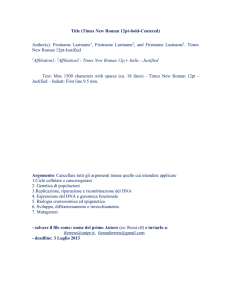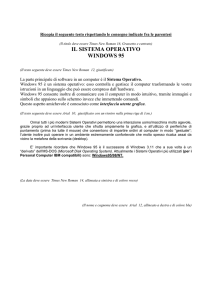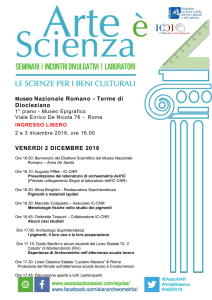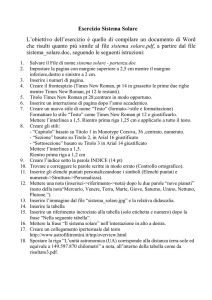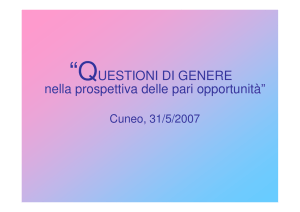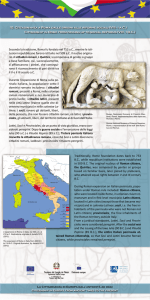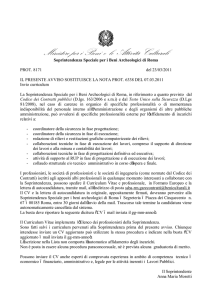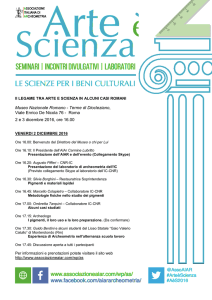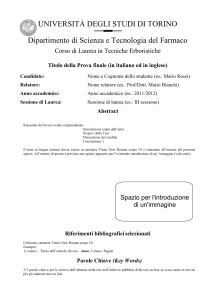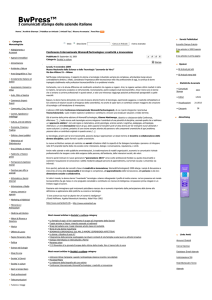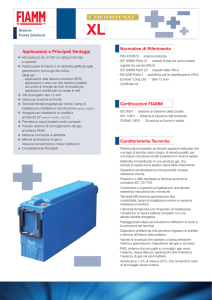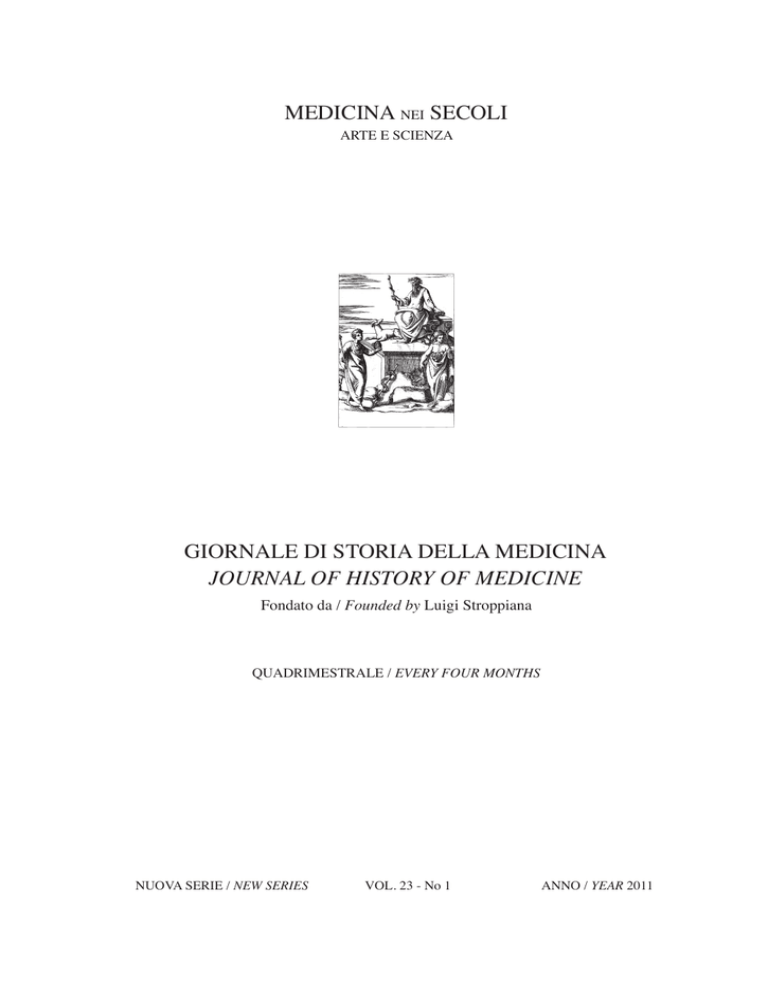
MEDICINA NEI SECOLI
ARTE E SCIENZA
GIORNALE DI STORIA DELLA MEDICINA
JOURNAL OF HISTORY OF MEDICINE
Fondato da / Founded by Luigi Stroppiana
QUADRIMESTRALE / EVERY FOUR MONTHS
NUOVA SERIE / NEW SERIES
VOL. 23 - No 1
ANNO / YEAR 2011
MEDICINA NEI SECOLI ARTE E SCIENZA, 23/1 (2011) 9-40
Journal of History of Medicine
Articoli/Articles
LA POUPÉE-DAME À L’ÉPOQUE ROMAINE IMPÉRIALE1:
UN SURPRENANT IMAGINAIRE DU CORPS FÉMININ
DANIELLE GOUREVITCH
École Pratique des Hautes études, Sciences historiques
et philologiques, Paris, F.
SUMMARY
THE ROMAN LADY-DOLL: A SURPRISING IMAGE OF THE FEMALE BODY
Ivory or bone lady-dolls found in Italy and in the Western empire, from the
2nd to the 5th century, seem to be erotic toys, with a beautiful hair-dress,
articulated body, and riche jewels, strange presents to be given to little
girls or young ladies. Archaeological and epigraphical documents, literary
texts, and present Barbies are put together.
En tant qu’historien de la médecine antique, je connais des corps de
femmes romaines sculptés ou modelés, qui ne sont pas beaux, mais
obèses, bossus, porteurs de luxation de la hanche, et j’en passe, renvoyant à l’ouvrage que j’ai écrit avec Mirko Grmek, Les Maladies
dans l’art antique (Paris, Fayard, 1998, trad. ital. pour Giunti à
Florence en 2000, a cura di Danielle Gourevitch e Martino Menghi).
C’est tout autre chose qu’offrent les poupées-dames, sculptées
dans l’os animal, ou mieux encore en un ivoire plus coûteux2. Elles
sont plus ou moins rafinées et élaborées, plus ou moins articulées
(épaule, coude, hanche, genou, pied). Elles mesurent entre une quinzaine de centimètres et une trentaine: elles peuvent être complètes,
mais le plus souvent elles sont incomplètes, voire très fragmentaires,
Key words: Lady-doll – Body - Rome
9
MEDICINA NEI SECOLI ARTE E SCIENZA, 23/1 (2011) 41-64
Journal of History of Medicine
Articoli/Articles
LA NECROPOLI DEL CASTELLACCIO (ROMA IV SEC. A C.IV D.C.): IL MONDO FEMMINILE
ANNA BUCCELLATO*, PAOLA CATALANO*, FULVIO COLETTI°,
WALTER PANTANO§
* Soprintendenza Speciale per i Beni Archeologici di Roma, ° Università
“La Sapienza” di Roma, § Collaboratore del Servizio di Antropologia della
Soprintendenza Speciale per i Beni Archeologici di Roma, I
SUMMARY
THE FEMALE WORLD IN THE NECROPOLIS IN CASTELLACCIO
(ROME, IV CENT. B.C., IV A.C.)
The archaeological investigation carried out from 2003 in the Castellaccio
locality, undertaken to realize the “Europarco” town planning, brought
to light a part of a road dated to the roman age, identiied as the ancient
via Laurentina. The road is oriented N/NE-S/SW, is 400 metres long and
cross with a bridge the Fosso dell’Acqua Acetosa. Two buildings run
alongside this trait of the ancient Laurentina: one can be interpreted as a
rural structure, the other one as a mansio. A sidestreet starts from the inal
edge of the recovered road and run toward East, along the original route
of the Fosso dell’Acqua Acetosa Ostiense: the historians recognized it as
a boundary of the Ager Romanus Antiquus nearby the VI mile, place of the
god Terminus sanctuary.
A necropolis made up of more than 130 graves, mainly inhumations, was found
in the southern part of the crossroads, near the oriental side of the Laurentina.
The stratigraphical analysis and the examination of the grave goods allowed
the characterization of three period of funerary use of the necropolis, between
the middle republican age and the irst two century of the Empire. In all three
period stand out graves of infants and women, of extreme interest from the
ritual point of view and supplied with rich grave goods.
Key words: Castellaccio – Laurentina – Necropoli - Sepolture femminili
41
MEDICINA NEI SECOLI ARTE E SCIENZA, 23/1 (2011) 65-96
Journal of History of Medicine
Articoli/Articles
UNO SPAZIO PER LA DONNA NELLA CASA ETRUSCA E
ROMANA (VI-I SEC. A.C.)?*
VINCENT JOLIVET
CNRS, UMR8546 - Paris
SUMMARY
A SPACE FOR WOMEN IN THE ETRUSCAN AND ROMAN HOUSES
(VI-I CENT. B.C.)?
The article analyzes the scientiic discussion about the existence of a
domestic space reserved to women in Etruscan and Roman houses. The
hypotesis regarding the existence of a ‘gynaeceum’ has been recently
proposed for the Etruscan houses built on Palatino in Rome (VI cent.
B.C.) and for the ancient phase of the Centaurus Protodomus in Pompei.
Considering the speciic role of Roman matronae as laniferae, and also a
substantial equality of social role between Etruscan men and women, it
is possible to advance the hypotesis of the existence of a room originally
reserved to women (oecus) on one side of the tablinum, the symmetrical
room being reserved to men (triclinium).
All’interno di un quadro geograico e cronologico omogeneo, se
una planimetria simile implica un’identità di usi e di funzioni,
almeno generica, si può ipotizzare che la casa di pianta canonica,
concepita in Etruria nel corso del VI secolo a.C. e che rimase in
uso - per un lasso di tempo alquanto eccezionale nel mondo antico
e non solo - ino al I secolo a.C., ha mantenuto, anche se soltanto in
Key words: Gynaeceum - Etruscan and Roman houses
65
MEDICINA NEI SECOLI ARTE E SCIENZA, 23/1 (2011) 101-118
Journal of History of Medicine
Articoli/Articles
LA PERCEZIONE DELLE AUGUSTAE NEL QUOTIDIANO
FEMMINILE
FRANCESCA CENERINI
Dipartimento di Storia Antica, Facoltà di Lettere e Filosoia,
Università di Bologna, I
SUMMARY
HOW AUGUSTAE WOMEN ARE PERCEIVED IN EVERYDAY LIFE
We basically have a double portrait of Augustae women, which means those
who belonged to domus Augusta. Ancient historians mostly describe them
as thirsty of power and obsessed by sexual desire. Whereas the coins, the
iconography and the oficial inscriptions gave us a propagandist image,
focused especially on the fact that the Augusta is supposed to give an
heir to the Emperor. The purpose of this work is to analyze the Augustae’s
eventual “popular” success. In order to do it, it was irstly catalogued all
the epigraphic material useful for this type of research. These inscriptions
are not many and, at present state of the research, they let us analyze the
popular favour of two Augustae: the acclamations written on Pompei
walls for Poppea, Nerone’s wife, and Faustina Minore’s role as marriage
guarantor and protector.
Le Augustae, ovvero le donne che hanno gravitato sulla domus
Augusta, hanno avuto un singolare destino. La loro immagine, fortemente negativa, è stata, per così dire, fossilizzata dagli scrittori antichi. Praticamente senza nessuna variazione dai ritratti a fosche tinte
elaborati da Tacito, Svetonio e Cassio Dione, per non parlare della
Historia Augusta, le immagini delle due Giulie, Maggiore e Minore,
Key words: Augustae – Poppaea – Faustina Minor – Iscriptions - Popular favour
101
MEDICINA NEI SECOLI ARTE E SCIENZA, 23/1 (2011) 123-146
Journal of History of Medicine
Articoli/Articles
NINFE, MATRONE E STREGHE
ALLA FONTANA DI ANNA PERENNA
MARINA PIRANOMONTE
Soprintendenza Beni archeologici di Roma, I
SUMMARY
THE ROMAN FOUNTAIN OF ANNA PERENNA
The article traces the history of the archaelogical indings at the Roman
fountain of Anna Perenna. Anna Perenna is a nymph, a Roman ancient
goddess, and her cult, well testiied from IV century a.C. to VI century d.C.,
is a central focus to comprehend the Roman perception of relationship
between religion and magic.
La mia scoperta della fontana di Anna Perenna ha ormai dieci anni,
e ha sicuramente cambiato molte certezze sulla percezione del rapporto degli antichi con il religioso e il magico: in questi anni molte
novità sono emerse da questo ritrovamento, molti studiosi mi hanno
aiutato, il gruppo di lavoro è molto ampio e internazionale1.
Anna Perenna è una ninfa, un’antica divinità romana delle origini,
che aveva una festa “via Flaminia ad lapidem primum” il giorno
delle Idi di Marzo secondo i Fasti Vaticani, Antiates e Farnesiani 2.La
dea è ampiamente menzionata in Ovidio 3 e Silio Italico4. Macrobio,
nelle Satire5 ricorda che il 15 marzo... “et publice et privatim ad
Annam Perennam sacriicatum itur, ut annare perennareque commode liceat”. Plinio il Vecchio parla forse di un Annae templum6.
Marziale rievoca l’ “Annae pomiferum nemus Perennae” visibile
Key words: Roman religion – Anna Perenna
123
MEDICINA NEI SECOLI ARTE E SCIENZA, 23/1 (2011) 151-172
Journal of History of Medicine
Articoli/Articles
SOTTO LA PROTEZIONE DELLE ELIADI
LA COLLANA DELLA TOMBA 660 DI MEGARA IBLEA
STÉPHANE VERGER*
EPHE, Paris
SUMMARY
THE NECKLACE FROM THE 660 GRAVE IN MEGARA IBLEA
The article analyzes the 660 grave in Megara Iblea, a Greek colony in
Sicily, in which a woman has been buried. On her breast a magniicent
neckless was found, made of amulets recalling the travel of the sun during
the summer solstice. Some objects allude to solar cults (a cock; round
pendants), others seem to came from Gallia and Macedonia (summer
far West and East), others recall archeological contexts such as tombs in
Marvinci, in the Vardar Valley, and allude to relations with female practices
of medicine and magic and to female roles characterized by extraordinary
powers, due to being descendants of the Sun god. These solar symbols,
joint with the discovery of many little objects, typical of children burials,
allow to hypotize a relation with the cult of Mater Matuta and seem to point
out a dificult or anomalous pregnancy or birth.
Ambre e scarabei nelle parures femminili dell’età del Ferro
A partire dall’VIII sec. a.C., in Italia meridionale e centrale, alcune
ricche parures femminili indigene presentano evocazioni allusive
dei limiti del mondo, che si manifestano attraverso l’associazione
di oggetti o di materie che si supponevano provenirne. Così, nelle
ricche inumazioni femminili del Villanoviano IIB della necropoli di
Quattro Fontanili a Veio in Etruria meridionale, si osserva un’assoKey words: Megara Iblea - Female burials - Solar cults - Mater Matuta Childbearing
151
MEDICINA NEI SECOLI ARTE E SCIENZA, 23/1 (2011) 177-200
Journal of History of Medicine
Articoli/Articles
LE DONNE A FRANCAVILLA MARITTIMA (COSENZA)
TRA MONDO INDIGENO E CITTÀ GRECA
ROSSELLA PACE
Università della Calabria, Dipartimento di Archeologia e Storia delle Arti, I
SUMMARY
WOMEN IN FRANCAVILLA MARITTIMA (CS) BETWEEN INDIGENOUS
WORLD AND THE GREEK CITY
Francavilla Marittima is a protohistorical site; its ancient traces dates
from the Medium Bronze Age. The article examines two female graves
in the Temparella Cairn, collecting 93 graves from VIII to VI cent. B.C..
Grave n. 8 preserved a rich female set (i.e. a loom weight; a ceramic pix; a
portable kotyle), made of imported and ‘masculine’ objects, here intended
for a female use. Grave n. 26 is characterised by a great number of vases,
turned upside- down to cover the body of a woman. This particular burial
modality recalls the religious cerimonies of Demeter in Gela; it probably
alludes not to a social role (a women seller of vases? An ‘object’ between
objects?) but to the speciic role of the dead inside a female cult.
Francavilla Marittima è uno dei maggiori siti protostorici della
Sibaritide, che ha avuto un ruolo notevole anche in età storica, quando, con la fondazione della colonia achea di Sibari nell’ultimo quarto dell’VIII secolo a.C., è sede di un importante Athenaion1.
Del sito conosciamo: il santuario, sulla cima del Timpone Motta,
l’abitato che si sviluppa sui tre pianori sottostanti e l’ampia necropoli al di là del torrente Dardanìa, in località Macchiabate.
Le tracce più antiche dell’insediamento risalgono al Bronzo medio.
Key words: Francavilla Marittima - Medium bronze age - Female burial setDemeter cults
177
MEDICINA NEI SECOLI ARTE E SCIENZA, 23/1 (2011) 205-222
Journal of History of Medicine
Articoli/Articles
ANTROPOLOGIA, FISIOLOGIA FEMMINILE E MALATTIE DI
DONNE NEGLI ANTICHI SCRITTORI CRISTIANI
EMANUELA PRINZIVALLI
Dipartimento di Studi Storico-Religiosi
Sapienza Università di Roma, I.
SUMMARY
FEMALE ANTHROPOLOGY, PHYSIOLOGY AND DISEASE IN ANCIENT
CHRISTIAN WRITERS
Ancient Christian sources are rich in reference to the anthropology and
physiology of the female. Christianity in the irst centuries had multiple
positions as concerns the doctrinal thoughts as well as the social practices.
Christian anthropological doctrine has been developed along two exegetical
lines, hinging on Genesis 1-3: the irst views the human being as a whole
psycophysical entity and thereby highlights the protological inferiority of
the woman; the second, spiritual and Platonic, emphasizes the inner self
and thus, in theory, is more equalitarian. Ancient philosophical theories
regarding human generation, in particular those of Aristotle and the Stoics,
are used, along with medical notions, by Christian theologians to elaborate
the dogma of incarnation. However, in certain cases, as with the post
partum virginity of Maria, medical theories are totally put aside. The stories
recounting the miracles offer the possibility of understanding medical
practices of female conditions and the emotive reactions of the women.
Tre presupposti del discorso
In apertura di discorso, enuncio e illustro sommariamente tre caratteri del cristianesimo antico (in realtà sempre risorgenti, in varie forKey words: Ancient Christian sources - Female anthropology- Female
physiology - Female pathology
205
MEDICINA NEI SECOLI ARTE E SCIENZA, 23/1 (2011) 227-254
Journal of History of Medicine
Articoli/Articles
REPRESENTATIONS AND REALITIES: CEMETERIES AS
EVIDENCE FOR WOMEN IN ROMAN BRITAIN
JOHN PEARCE
Department of Classics, King’s College London, UK
SUMMARY
The article considers how burial evidence might contribute to the
undestarnding of gender, i.e. the socio-cultural construction of sexual
difference, as a dynamic aspect of identity in a Roman province, with a
particular focus on women. This subject has hitherto received limited
attention and its potential is too great to explore fully in a short paper.
Given this costraint, the article indicates possibilities and problems rather
than to offer deinitive conclusions. Its emphasis lies on Roman Britain,
but similar questions could be applied to other parts of the Roman world.
Introduction
In this article I consider how burial evidence might contribute to the
understanding of gender, i.e. the socio-cultural construction of sexual
difference, as a dynamic aspect of identity in a Roman province, with
a particular focus on women. This subject has hitherto received limited attention and its potential is too great to explore fully in a short paper. Given this constraint, I aim to indicate possibilities and problems
rather than to offer deinitive conclusions. I hope this will also excuse
the broad-brush characterisations of other work on the archaeology
of gender which I present as the context in which to set the study of
burial. My emphasis lies on Roman Britain, since I am more familiar
Key words: Roman women - Burial practices - Gender construction
227
MEDICINA NEI SECOLI ARTE E SCIENZA, 23/1 (2011) 259-286
Journal of History of Medicine
Articoli/Articles
SEPOLTURE FEMMINILI DALLE NECROPOLI DEL
SUBURBIO OSTIENSE: NUOVI DATI DAI RECENTI SCAVI
ARCHEOLOGICI
SIMONA PANNUZI*, WALTER PANTANO°
* Soprintendenza Speciale per i Beni Archeologici di Roma – sede di Ostia, I
° Collaboratore del Servizio di Antropologia della Soprintendenza Speciale per i
Beni Archeologici di Roma, I
SUMMARY
FEMALE FUNERARY CONTEXTS IN THE OSTIENSE SUBURBIUM: NEW DATA
This work concern several indings of the last years in funerary contexts
in the Ostiense suburbiums, during archaeological investigations
carried out by the Soprintendenza Archeologica of Ostia. The latest
excavations provided new data to understand the width of the vast
funerary area, that probably extended uninterruptedly from East to
South of the ancient city of Ostia. New evidences about the funerary
rituals came to light, and emerged irst anthropological data referred
to inhumated and cremated people from Ostia. The results, compared
with those obtained from the numerous Rome’s necropolis, bring to a
preliminary reconstruction of the burial practices in a territory directly
connected with Rome, where are reported female’s graves of extreme
archaeological and anthropological interest.
Introduzione
Il presente contributo riguarda una serie di ritrovamenti di ambito funerario effettuati in questi ultimissimi anni nel suburbio ostiense durante scavi di pubblica utilità ed in un caso durante indagini archeoKey words: Ostia - Necropoli - Sepolture femminili
259
MEDICINA NEI SECOLI ARTE E SCIENZA, 23/1 (2011) 291-302
Journal of History of Medicine
Articoli/Articles
LA DONNA COME FORZA LAVORO NELLA ROMA
IMPERIALE: NUOVE PROSPETTIVE DA RECENTI SCAVI
NEL SUBURBIO
VALENTINA BENASSI◊, ANNA BUCCELLATO§, CARLA CALDARINI◊,
PAOLA CATALANO§, FLAVIO DE ANGELIS°, ROBERTO EGIDI§, SIMONA
MINOZZI#, STEFANO MUSCO§, ALESSIA NAVA◊, WALTER BENEDETTO
PANTANO◊, RITA PARIS§, LISA PESCUCCI◊
§
Soprintendenza Speciale per i Beni Archeologici di Roma; ◊ Collaboratore del
Servizio di Antropologia della Soprintendenza Speciale per i Beni Archeologici di
Roma; #Divisione di Paleopatologia, Storia della Medicina e Bioetica, Dipartimento
di Oncologia, dei Trapianti e delle Nuove Tecnologie in Medicina, Università di
Pisa; °Dipartimento di Biologia, Università degli Studi di Roma “Tor Vergata”.
SUMMARY
WOMAN AS WORK FORCE IN THE IMPERIAL ROME: NEW PROSPECTIVES
FROM RECENT EXCAVATIONS IN THE ROMAN SUBURBS.
The systematic excavation of funerary sites carried out by the Soprintendenza
Speciale per i Beni Archeologici di Roma during the last years, has allowed
the collection of a considerable amount of bio-archaeological data. This
work try to highlights the role of the woman in the roman society as work
force, examining several biomechanical stress markers in the skeleton.
The sample consist of 1041 individuals, coming from areas surrounding the
urban centre and the rural environment nearby the City and chronologically
framed in I-III century AD. Considering together the biological and the
archaeological data, we tried to understand the occupational activities in
which the women could be involved.
Key words: Woman - Work Forces - Roman Imperial Age
291
MEDICINA NEI SECOLI ARTE E SCIENZA, 23/1 (2011) 307-314
Journal of History of Medicine
Articoli/Articles
NECROPOLI DI CASTELLACCIO
CORREDO DELLA TOMBA N.116
IDA ANNA RAPINESI*, DANIELA FERRO
Laboratorio di Restauro Soprintendenza Speciale per i Beni Archeologici di Roma*
Centro per lo Studio dei Materiali Nanostrutturati del CNR - Roma
SUMMARY
NECROPOLIS IN CASTELLACCIO, TOMB N. 116
The article analyzes the grave goods contained in the tomb n. 116 in the
Necropolis of Castellaccio in Rome (IV Cent. B.C.- IV cent. A.C.) and
offers a description of a bracelet and some rings, analyzed by electronic
microscope and by EDS.
Bracciale in oricalco inv. n.536432
Diam cm. 5.5
h. cm. 0.5
spessore lamina: mm.0,3 ca
Gruppo anelli in oricalco inv. 536431
Diam. sezione verga: mm. 1 ca
Diam. anello cm 1,6
Il corredo della defunta è costituito da un bracciale rinvenuto in due
frammenti sul braccio sinistro e da alcuni anelli ancora posti sulle falangi della mano sinistra. Anche gli anelli erano allo stato frammentario e/o lacunoso. Dall’esame della documentazione riguardante lo
Key words: Castellaccio necropolis - Grave goods
307
MEDICINA NEI SECOLI ARTE E SCIENZA, 23/1 (2011) 319-342
Journal of History of Medicine
Articoli/Articles
QUALCHE OSSERVAZIONE SULLA COMPONENTE
FEMMINILE DELLA COMUNITÀ LAZIALE DI
CRUSTUMERIUM (IX-V SEC. A.C.)
BARBARA BELELLI MARCHESINI, FRANCESCO DI GENNARO
Soprintendenza Speciale per i Beni Archeologici di Roma, Roma, I
SUMMARY
SOME OBSERVATIONS ABOUT WOMEN IN THE LATIN SETTLEMENT
OF CRUSTUMERIUM (IX-V CENTURY B.C.).
A short discussion of the female tombs of Crustumerium is here attempted,
considering the entire chronological span of exploitation of the settlement
and pointing out the distinctive criteria of gender and the demographic
trend suggested by both archeological and anthropological preliminary
analysis. The most meaningful funerary goods which were selected to point
out the social position and the role of women inside the community are
taken into account.
L’ambito cronologico indicato, dal nono al quinto secolo a. C., è
quello che corrisponde, su basi archeologiche e storiche, alla esistenza della comunità latina di Crustumerium1.
Infatti Crustumerium (Fig. 1) nasce probabilmente non prima della
fase IIB della sequenza laziale, che oggi si fa rientrare nel secolo
IX a.C.2, e non esiste più -o almeno non manifesta alcuna rilevanza- al tempo della disfatta romana dell’Allia, risalente al primo decennio del IV secolo a.C.3. Il lasso di tempo che vede prosperare
Crustumerium, considerato anche che già dal V secolo a.C. le atteKey words: Crustumerium - Female goods - Female role
319

